Abstract
THE Japanese had an unquestionable advantage in the recent war as being smaller than the Russians; they were smaller targets for fire-arms. I wish to point out that it is possible to express this advantage quantitatively on the assumption, justifiable in modern war, that bullets are, on the average, uniformly distributed over the target presented by a man's body, also that a man presents a target proportional in area to the square of his height. The Anthropological Institute has kindly given me figures for the purpose; the average height of 2500 Japanese, 1260 of them being soldiers, was 1585 millimetres as compared with an average of 1642 millimetres for the average of 177,948 European Russian conscripts. The average Russian height thus exceeds that of the Japanese by about 3.47 per cent. The squares of the two average heights, representing, as I have said, the average targets offered by each to an enemy, differ therefore approximately by 7 per cent., so that the Russian fire was relatively ineffective to that extent.
This is a preview of subscription content, access via your institution
Access options
Subscribe to this journal
Receive 51 print issues and online access
$199.00 per year
only $3.90 per issue
Buy this article
- Purchase on SpringerLink
- Instant access to full article PDF
Prices may be subject to local taxes which are calculated during checkout
Similar content being viewed by others
Author information
Authors and Affiliations
Rights and permissions
About this article
Cite this article
TWIGG, J. Result of War affected by Soldier's Stature. Nature 73, 340 (1906). https://doi.org/10.1038/073340e0
Issue date:
DOI: https://doi.org/10.1038/073340e0



